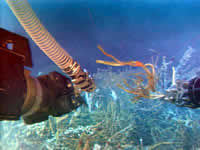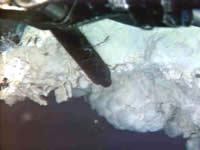| |
| |

ROPOS uses both it's arms (5-function on
the left and 7-function on the right) to collect samples for the many
scientists on board the Ron Brown. Attached to the left arm is the
suction sampler, while the right hand is used to grab a sample of
tube worms at Cloud vent (1524 meters).

The hot fluid sampler is pictured
in the upper foreground sampling the
underside
of a pillow lava coated with bacterial mat at marker N-3 (1528 meters).
The
chemists and microbiologists are collecting water samples and also
getting
in-situ measurements of pH and sulfides from the vent fluids. |
|
NOAA Ship Ron Brown/ROV ROPOS
Science News
Science Report - Friday, July 20, 2001
Ship's position: 45 54.9/-129 59.4'
ROPOS
is in the middle of another long dive (623) which is visiting sites both
inside and outside the caldera with a pressure sensor. The pressure sensor
precisely measures the depth at an array of points on the seafloor to
see if the center of the caldera is going up or down (inflating or deflating)
relative to a point outside. During the 1998 eruption, the center of the
caldera subsided over 3 meters (!) as magma was removed from the magma
reservoir beneath the caldera and was intruded into the south rift zone.
Between eruptions that magma that was removed must gradually get replenished
from Axial's "hot spot" source in the earth's mantle. We are
trying to measure if that is going on to see whether or not Axial is already
building up to its next eruption. Today's dive also visited the Marker
33/Cloud and Bagcity vent areas on the 1998 lava flow since they were
on the way to take additional suction samples, position larval traps and
settling arrays, and deploy miniature temperature recorders. Tomorrow's
dive will be our first visit to the ASHES vent field this year.
|
|

